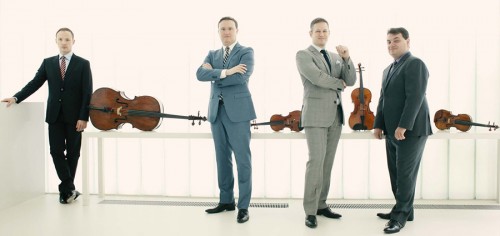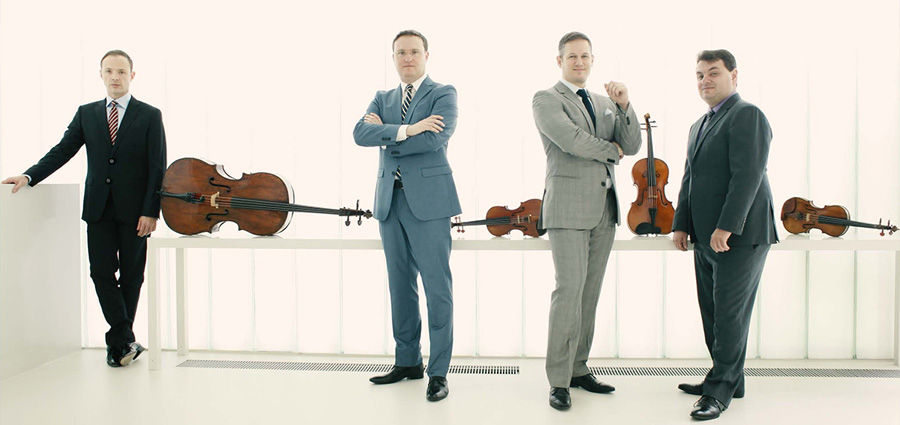 United Kingdom Bartók: Jerusalem Quartet (Alexander Pvolovsky, Sergei Bresler [violins], Ori Kam [viola], Kyril Zlotnikov [cello]). Wigmore Hall, London, 8.5.2019. (MB)
United Kingdom Bartók: Jerusalem Quartet (Alexander Pvolovsky, Sergei Bresler [violins], Ori Kam [viola], Kyril Zlotnikov [cello]). Wigmore Hall, London, 8.5.2019. (MB)

Bartók – String Quartet No.1; String Quartet No.3; String Quartet No.5
This was the first of two concerts in which the Jerusalem Quartet would perform Bartók’s six string quartets. If there were slight frustration in my only being able to hear the first, it surely augured well for the second, which I look forward to hearing about, if not, alas, to hearing.
The particular, sometimes competing demands of early Bartók can prove difficult to bring off: no such problem here, in as fine a performance of the First Quartet (1908-9) as I can recall hearing. The opening chromaticism of the violin-duo opening signalled a strongly Schoenbergian presence: one, I think, that endured throughout the quartet and beyond it. For it was not only in the score, though there it certainly was; it was played as such, too, intense yet variegated, in an unmistakeably Austro-Hungarian performance. The Jerusalem Quartet players showed keen ears – and a keen collective ear – for form and structure, expressed without didacticism, born from and living through the notes and their connections. Contrapuntal procedures were invested with dynamism both intellectual and emotional. And how each instrument came into its own through that! New possibilities were signalled and taken in the second movement, which struck a fine balance at its opening between emergence from what had gone before and contrast therewith. The finale brought to life a rhetorical disjuncture that had something of Beethoven to it: not in the banal sense of sounding ‘like’ Beethoven’s music, but in spirit, in reinvention. Bartók’s music already seemed to presage the world of Bluebeard, its dramatic flight a product of fierce conviction in performance.
If that final movement, even in the strongest performance such as this, seems nonetheless to go on a little, no one could seriously make such a claim concerning the Third Quartet (1927). Tonality here seemed less on the verge of suspension than beside the point – until it was otherwise. It was certainly motivic working above all that afforded the dynamism in this performance of the opening ‘Prima partie’: dialectical motivic working, that is, in the line of Bach and Beethoven. The music’s emotional intensity somehow seemed both greater and more sparing: surely testament to Bartók’s mastery of form and genre by this stage in his career. The slow-fast ‘Hungarian’ relationship of the first two movements likewise seemed brought to perfection: internalised and thus the more meaningfully expressed. The ‘Recapitulazione della prima parte’ sounded, rightly, not so much as reconciliation but as arbiter and moulder of memory. It was as new as it was old, paving the way for an explosive coda section, as richly developmental within its concise frame as the score from which this magnificent performance sprang.
The Fifth Quartet (1934) had the second half to itself. That uncompromising intensity, intellect and emotion as one, characteristic of both works so far persisted, reinvented itself here too in its first movement and beyond. The players afforded the first subject – I think we can safely call it that – great detail without the slightest suspicion of fussiness, strokes broad, fine, even both, or so it seemed. A pale delirium, increasingly less pale, characterised the response: just as involving, quietly and less quietly generative. Disjuncture and coherence, melodic line and complexity played out in a fashion that perhaps inevitably brought late Beethoven to mind. It made me long to hear the Jerusalem Quartet in Ligeti too. How strange the final poco allargando phrase sounded, yet also how right. I loved the sense imparted in the following ‘Adagio molto’ of a somewhat disoriented and disorienting hymn. (Again, Beethoven’s precedent seemed fruitfully, never oppressively, immanent.) It is ‘night music’, of course, but far more than that. So too is the fourth movement, whose harmony likewise remained fundamental in a not un-Classical way, very much providing a sense of the celebrated Bartókian arch. In between, the scherzo had held harmony, melody, and yes, of course metre in fruitful, riveting dialogue: Haydn for the 1930s. It was Beethoven’s ghost that again lightly haunted the finale, titanic effort to wield material together amply rewarded. But if there were unanimity of purpose, there was equally fierce independence of instrumental voice within that purpose and progress. For work, ensemble, and performance alike, this was emphatically a string quartet.
Mark Berry
